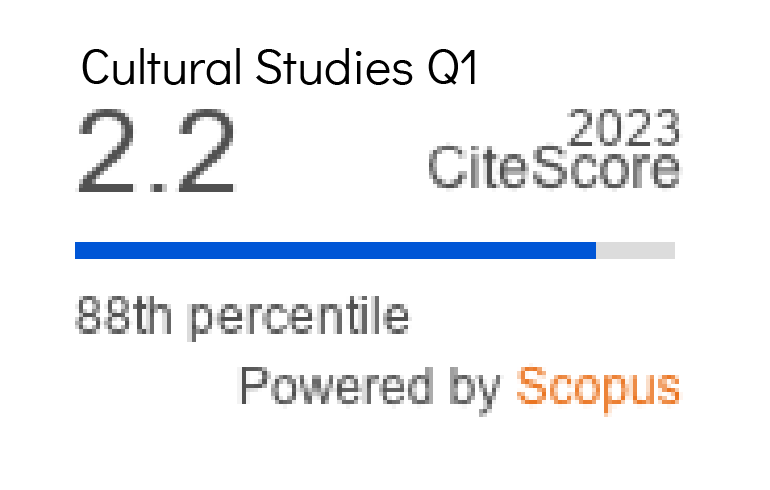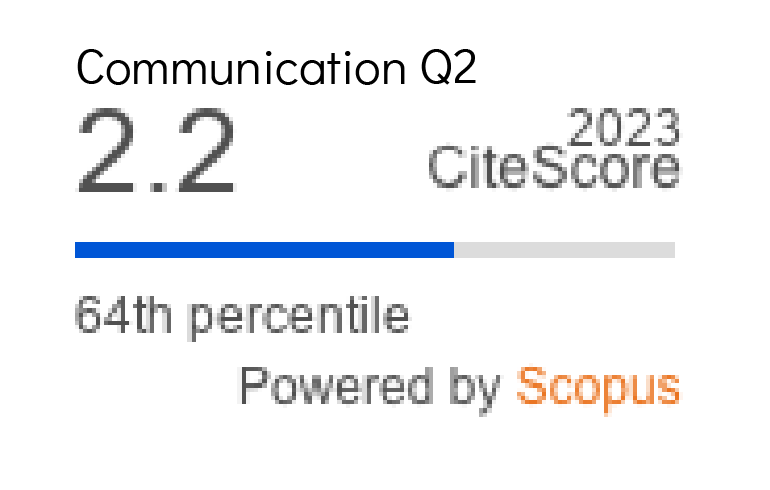La relación de los consumidores maduros con su perfume
DOI:
https://doi.org/10.14198/MEDCOM2018.9.1.22Palabras clave:
Relación de marca de consumo, Lujo, Consumidores maduros, PerfumeResumen
Glamuroso y elegante, el perfume es un producto evocador que provoca un estímulo de los sentidos. El uso de perfume es reconocido como una parte importante de la preparación diaria para muchas mujeres. Se sugiere que la base para la elección del consumidor para este producto debe basarse en la preferencia olfativa, sin embargo, la toma de decisiones relacionada con el proceso ha demostrado ser más compleja. La toma de decisiones de compra del consumidor maduro en esta categoría de productos se asocia a menudo con las marcas de fragancias de lujo establecidas hace tiempo. Además, en la primera línea del proceso de venta de perfumes se encuentran los consultores de fragancias. Con el contacto directo con el consumidor, estos "embajadores de la marca" poseen inestimable información sobre la participación de los consumidores en productos y marcas de perfumes. Por lo tanto, este trabajo investiga la relación CBR (consumer brand relationship) y el comportamiento subsiguiente de compra de perfumes de consumidores maduros (edad +44) desde una perspectiva dual (industrial y de consumo). Los resultados indican que existen importantes diferencias perceptuales relacionadas con las relaciones de marca con el perfume entre consultores de fragancia y expertos por un lado y consumidores por el otro. Esta investigación promueve una comprensión más profunda del enfoque actual del consumidor y las cuestiones relacionadas con el comportamiento de compra maduro femenino para esta categoría única de producto, y complementa el creciente cuerpo de literatura relacionada con las marcas de lujo.
Citas
Aaker, J. L. (1997). Dimensions of brand personality. Journal of Marketing Research, 34(3), 347-356. https://doi.org/10.2307/3151897
Albert, N. & Merunka, D. (2013). The role of brand love in consumer-brand relationships. Journal of Consumer Marketing, 30(3), 258-266. https://doi.org/10.1108/07363761311328928
Ball, A. D. & Tasaki, L. H. (1992). The role and measurement of attachment in consumer behaviour. Journal of Consumer Psychology, 1(2), 155-172. https://doi.org/10.1207/s15327663jcp0102_04
Bowlby, J. (1979). The making and breaking of affectional bonds. London: Tavistock,
Cant, M. C. ; Strydom, J. W.; Jooste, C. J. & Du Plessis, P. J. (2009). Marketing management [5th Ed.]. South Africa: Juta Academic.
Edwards, M. (2015). Fragrances of the world [31st Ed.]. Australia: Fragrances of the World.
Fetscherin, M. & Heinrich, D. (2015). Consumer brand relationships research: A bibliometric citation meta-analysis. Journal of Business Research, 68(2), 380-390. https://doi.org/10.1016/j.jbusres.2014.06.010
Fournier, S. (1998). Consumers and their brands: Developing relationship theory in consumer research. Journal of Consumer Research, 24(4), 343-353. https://doi.org/10.1086/209515
Gardyn, R. (2002). Oh, the good life. American Demographics, 24(10), 31-35.
Genders, R. (1972). A history of scent. Hamilton.
Granot, E.; Greene, H. & Brashear, T. G. (2010). Female consumers: Decision-making in brand-driven retail. Journal of Business Research, 63(8), 801-808. https://doi.org/10.1016/j.jbusres.2010.04.006
Holbrook, M. B. (1993). Nostalgia and consumption preferences: Some emerging patterns of consumer tastes. Journal of Consumer Research, 20(2), 245-256. https://doi.org/10.1086/209346
Holbrook, M. B. & Schindler, R. M. (1991). Echoes of the dear departed past: Some work in progress on nostalgia. Advances in Consumer Research, 18(1), 330-333. Disponible en https://goo.gl/TZWKQM
Holt, D. B. (2004). How Brands Become Icons: The Principles of Cultural Branding. Cambridge: Harvard Business Press.
Holt, D. B. (2005). How Societies Desire Brands: Using Cultural Theory To Explain Brand Symbolism. En Ratneshwar, S. & Mick, D. G. (Eds.), Inside Consumption (pp. 273–291). London: Routledge.
Keller, K. L. (2014). Consumer brand relationships. Journal of Brand Management, 21(5), 365. https://doi.org/10.1057/bm.2014.21
Key Note. (2014). Cosmetics and fragrances. UK: Key Note Limited.
Kim, H. (2000). Examination of brand personality and brand attitude within the apparel product category. Journal of Fashion Marketing and Management: An International Journal, 4(3), 243-252. https://doi.org/10.1108/eb022593
Lambert-Pandraud, R. & Laurent, G. (2010). Why do older consumers buy older brands? The role of attachment and declining innovativeness. Journal of Marketing, 74(5), 104-121. https://doi.org/10.1509/jmkg.74.5.104
Libby, C. (2014). Men's and women's fragrances - UK - 2014. UK: Mintel Group Ltd.
Malär, L.; Krohmer, H.; Hoyer, W. D. & Nyffenegger, B. (2011). Emotional brand attachment and brand personality: The relative importance of the actual and the ideal self. Journal of Marketing, 75(4), 35-52. https://doi.org/10.1509/jmkg.75.4.35
Matthews, I. (12/2009). Women's fragrance buying habits revealed. Esprit. Disponible en https://goo.gl/PZgD1Y
Neudecker, N.; Hupp, O.; Stein, A. & Schuster, H. (2013). Is your brand a one-night stand? Managing consumer-brand relationships. Marketing Review St.Gallen, 30(6), 22-33. https://doi.org/10.1365/s11621-013-0297-8
Nobre, H. M.; Becker, K. & Brito, C. (2010). Brand relationships: A personality-based approach. Journal of Service Science and Management, 3(2), 206-217. https://doi.org/10.4236/jssm.2010.32026
Orth, U. R.; Limon, Y. & Rose, G. (2010). Store-evoked affect, personalities, and consumer emotional attachments to brands. Journal of Business Research, 63(11), 1202-1208. https://doi.org/10.1016/j.jbusres.2009.10.018
Oxford Dictionaries (s.f.). [Página web]. Disponible en https://goo.gl/Vrc1wm
Park, C.W.; MacInnis, D.J.; Priester, J.; Eisingerich, A.B. & Iacobucci, D. (2010) Brand Attachment and Brand Attitude Strength: Conceptual and Empirical Differentiation of Two Critical Brand Equity Drivers. Journal of Marketing, 74, 1-17. https://doi.org/10.1509/jmkg.74.6.1
Qing, Y.; Rong, C. & Xiaobing, X. (2015). Consistency between Consumer Personality and Brand Personality Influences Brand Attachment. Social Behavior and Personality: an international journal, 43(9), 1419-1427. https://doi.org/10.2224/sbp.2015.43.9.1419
Rambourg, E. (2014). The bling dynasty: Why the reign of chinese luxury shoppers has only just begun. UK: Wiley.
Richmond, A. (2012). Men's and women's fragrances - UK- september 2012. Mintel Group Ltd.
Schindler, R. M. & Holbrook, M. B. (1993). Critical periods in the development of men's and women's tastes in personal appearance. Psychology & Marketing, 10(6), 549-564. https://doi.org/10.1002/mar.4220100607
Szmigin, I. & Carrigan, M. (2001). Learning to love the older consumer. Journal of Consumer Behaviour, 1(1), 22-34. https://doi.org/10.1002/cb.51
Thomson, M.; MacInnis, D. J. & Park, C. W. (2005). The ties that bind: Measuring the strength of consumers’ emotional attachments to brands. Journal of Consumer Psychology, 15(1), 77-91. https://doi.org/10.1207/s15327663jcp1501_10
Verdict. (2014). Health & beauty retailing in the UK. UK: Datamonitor.
Estadísticas
Publicado
Cómo citar
Número
Sección
Licencia
Derechos de autor 2018 Lindsey Drylie-Carey, Aileen Stewart

Esta obra está bajo una licencia internacional Creative Commons Atribución-CompartirIgual 4.0.
Los autores y autoras que publican en esta revista están de acuerdo con los siguientes términos:
1 Derechos de autor. Los autores y autoras conservan sus derechos de autor, aunque ceden a la revista de forma no exclusiva los derechos de explotación (reproducción, distribución, comunicación pública y transformación) y garantizan a esta el derecho de primera publicación de su trabajo, el cual estará simultáneamente sujeto a la licencia indicada en punto 2. Los autores pueden establecer otros acuerdos adicionales para la distribución no exclusiva de la versión de la obra publicada en la revista, siempre que exista un reconocimiento de su publicación inicial en esta revista.
© Los autores.
2 Licencia. Los trabajos se publican en la revista sujetos a la licencia de Reconocimiento 4.0 Internacional de Creative Commons (CC BY 4.0); los términos se pueden consultar en https://creativecommons.org/licenses/by/4.0/
Esta licencia permite a terceros compartir (copiar y redistribuir el material en cualquier medio o formato) y adaptar (remezclar, transformar y crear a partir del material para cualquier finalidad, incluso comercial), siempre que se reconozca la autoría y la primera publicación en esta revista (Revista Mediterránea de Comunicación (RMC) / Mediterranean Journal of Communication (MJC), Universidad de Alicante, DOI de la obra), se proporcione un enlace a la licencia y se indique si se han realizado cambios en la obra.
3 Política de autoarchivo. Se recomienda a los autores que difundan sus trabajos a través de Internet para favorecer una circulación y difusión más rápidas y, con ello, un posible aumento en la citación y alcance entre la comunidad científica y académica, en las siguientes condiciones:
No se permite a los autores depositar en un repositorio institucional o temático, página web propia, etc., las versiones preprint (versión antes de ser evaluada) o postprint (versión evaluada y aceptada para su publicación) de sus trabajos antes de su publicación, pero sí el artículo final publicado (versión del editor).












